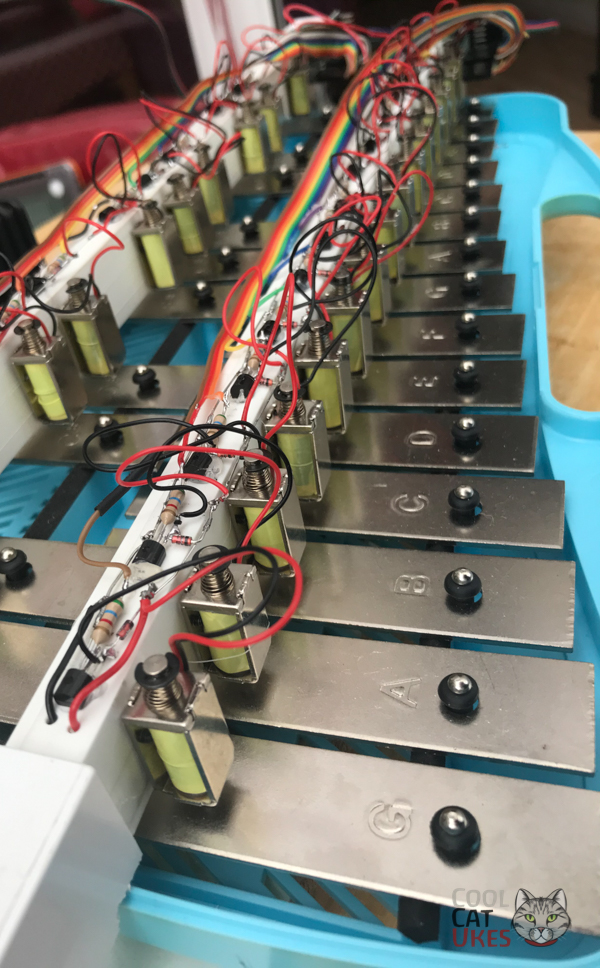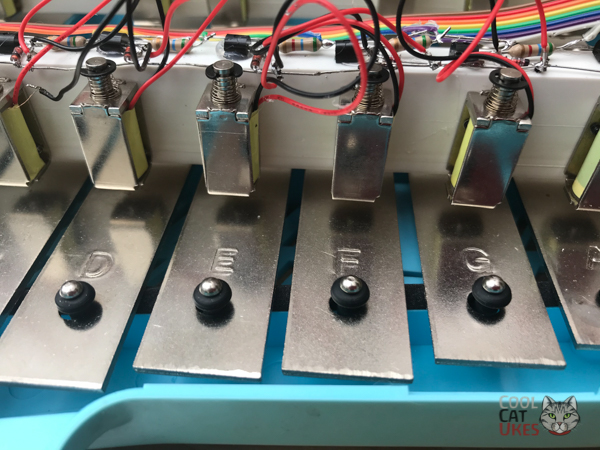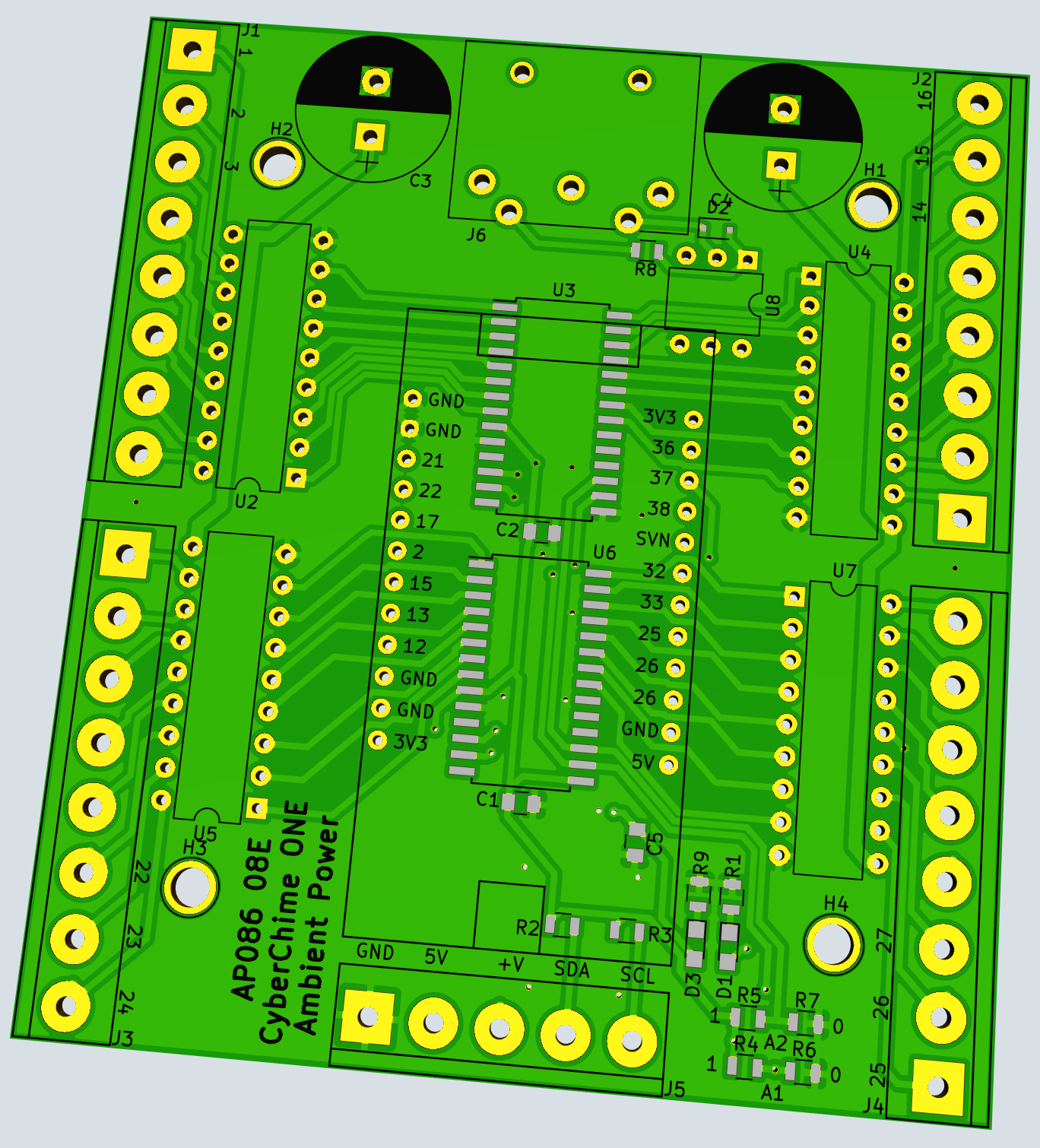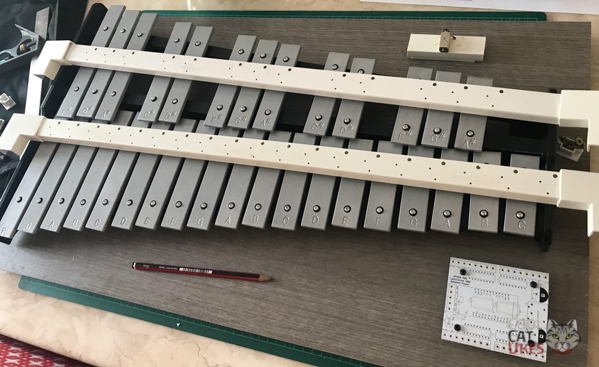
It's funny how strange ideas come to mind. I bought a little school style Glockenspiel a while ago, and to be honest have hardly used it. For those who wonder, Glockenspiels are made of metal, Xylophones are made of wood, and I think Marimbas are huge xylophones (I love the sound of those).
So, the Glockenspiel comes with two sticks (beaters) and in a folding plastic case. You hit the notes with the sticks, and it rings like a doorbell. You can play two notes at once, and some people can manage to hold two beaters in each hand, so the maximum notes becomes four, but it gets pretty tricky. With my engineering background, there had to be a solution.
Enter an embedded computer - an ESP32 processor from Espressif. In one tiny chip just there is 448KB or ROM, 520KB of RAM and a 240MHz/600DMIPS processor. Pretty powerful. It has I/O lines and supports WiFi, Bluetooth & Bluetooth LE. I used one built up on a ready built 50mm x 25mm module that has a tiny OLED display. The display isn't needed, but it's handy for some feedback that things are working well, and it looks cool! One of the other things I do is write firmware for embedded devices via my own business Ambient Power, so I set to writing the code.

To operate the notes, they are hit with solenoids that are activated for 1/100th of a second, 25 of these for all the sharps and flats in this Glockenspiel. Each solenoid needs about 120mA of current, more than the little processor can supply, so there are FETs (field effect transistors) and support components for those. Also, there were not quite enough I/O lines, so some I/O expanders were employed, working over I2C. Add some electrolytic capacitors for the solenoid surge currents and there you have it.

The main issue really is the current. With a 2A power supply, up to eight solenoids can be operated at once. Enough for most chords.
So, now I have a device that can play notes controlled from a computer. How to get notes into the computer? Well, most keyboards and synthesisers use MIDI, with keyboards outputting MIDI data and synths and sound modules receiving it. Basically, what I have is a synthesiser, so I implemented a MIDI receiver over Bluetooth, and instantly I can control it from a MIDI keyboard, or better still, a computer that can send MIDI files. These can be found on the internet, or you can create your own, and instantly, you have an automated band member! It's a true MIDI controlled Glockenspiel. I've christened it CyberChime ZERO.

Specifications:
- Bluetooth MIDI receive
- 5 pin wired MIDI receive (ONE)
- Midi channel configurable to required channel
- 8 notes playable simultaneously
- Maximum note play rate 40Hz
- ZERO - 25 notes G5 to G7 (784Hz to 3136Hz / MIDI notes 79 to 103)
- ONE - 32 notes F5 to C8 (698Hz to 4186Hz / MIDI notes 77 to 108)
- Processor: embedded Espressif ESP32 with Ambient Power firmware
- Firmware updateable OTA via WiFi
- Power supply: 90-240V
- Dimensions 500 x 240 x 100mm (ZERO), 695 x 400 x 120mm (ONE)
- Weight 2000g (ZERO), 5000g (ONE)
The really cool thing with a device such as this, is that it's limited only by the programming. So, it can play the Glockenspiel in a way and at a speed that no human could ever do. And I can make it do it!
Here are a couple of videos, one is the first test playing 'Flight Of the Bumble Bee' by Nikolai Rimsky-Korsakov, and the other a 'duet' with myself playing Kraftwerk's 'The Model'.
Flight Of The Bumble Bee on CyberChime ZERO
The Model duet with CyberChime ZERO

What's next? Well, I have a band-standard "orchestral" glockenspiel on its way to me now, and I'll engineer the electronics onto a single PCB so the whole thing can be made in a much tidier and repeatable way. The firmware is pretty much complete. In an advanced state of design is a proper PCB to contain all of the electronics. This is CyberChime ONE.
Update 22nd September 2020:
CyberChime ONE is well underway with the new PCB working, baseboard and mechanics all sorted out for the new 32 key device. Jigs made to help align solenoids on the cross bars, dimensions documented, so the new instrument will be repeatable.
 New controller PCB. |
 Testing the PCB with solenoids. |
 Jig to allow accurate drilling of crossbars. |
 New instrument takes shape. |
Thunderstruck - CyberChime ZERO solo
Update 25th October - all the new PCBs are here, they all work just fine, but alignment of the solenoids has proven tricky. I'm awaiting some custom adjustable brackets to make it all work, then CyberChime ONE should be ready.
Left Bank Two - the Vision On Gallery Theme - CyberChime ZERO
Update 17th November - finally, we have the new brackets and CyberChime ONE is alive. Here's a video of the first test. The new article on CyberChime ONE is here.
CyberChime ONE first test
Article - Simon Taylor, 29th August 2020

Even more weird sounds from Farnborough...
